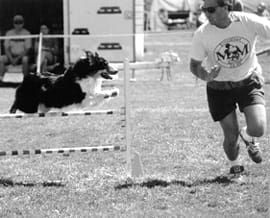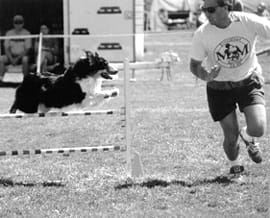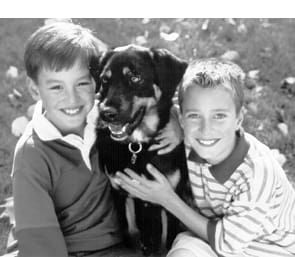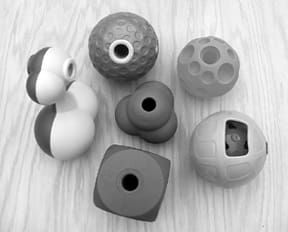We’re all looking for the mythical “perfect veterinarian,” right? Most animal guardians I’ve known would gladly pledge their undying support to a veterinary practitioner who could offer high-tech diagnostic tools and skills; a deep knowledge of pathology, nutrition, and conventional medicine; and the ability and willingness to utilize appropriate alternative and complementary therapies.
Unfortunately, this “perfect vet” is an extremely rare find. Most of us – people who embrace both conventional medicine as well as herbs, chiropractic, acupuncture, and other holistic medicines – have to resort to “building” our perfect veterinarian. Most of us do this by assembling a team of healthcare providers, each of whom is consulted for diagnosis or treatments that he or she is best able to provide.
This is, admittedly, a less-than-perfect solution, because sometimes these gifted professionals strongly disagree about “what’s best,” and you and your dog are caught in the middle.
For example, what happens when your brilliant and local conventional practitioner – the person you rely on for routine examinations and emergency care – is adamant about administering annual vaccinations to all her patients (and you are opposed to them)? Or when the same veterinarian wants you to put your elderly Labrador on Science Diet’s anti-arthritis food and Rimadyl – but you know your dog is better-served by a raw diet, nutritional supplements, and monthly acupuncture treatments?
I’ve heard many stories from people who use holistic practices and get tired of being pressured by their conventional veterinarians to (over) vaccinate, use (sometimes harmful) drug therapy as a first (not last) resort, or feed their dogs a commercial (low-quality) kibble. Sometimes, in an effort to find more sympathetic veterinarians, these caring guardians replaced their conventional primary practitioner with a holistic veterinarian – only to be disappointed by this professional’s resistance to useful conventional medicine!
In order to best utilize a “team” or network of healthcare providers for our dogs, it’s best to be aware of some of the potential pitfalls, as well as the benefits, of this approach. The following experiences clearly illustrate both.
Finding her own path
Christine Swingle, who raises West Highland White Terriers in Connecticut, has spent years contemplating this problem. She became interested in holistic medicine in 1996, when Summer, one of her cherished Westies, was misdiagnosed by a veterinarian who had treated Swingle’s dogs for decades. Two weeks later, despite intensive care from specialists at a highly regarded animal hospital in Massachusetts, Summer died. Swingle turned her grief into determination to find a better way to keep her Westies healthy.
Guided by Juliette de Bairacli Levy’s Complete Herbal Handbook for the Dog and Cat, Swingle began feeding her dogs a well- balanced raw diet. “As I continued my research,” she says, “I realized how ignorant and isolated I had been all my life. Treating the whole patient instead of specific conditions was a giant shift for me, especially because I had been a vet tech for 18 years. Until then, I believed 100 percent in conventional allopathic medicine.”
In addition to changing their diet, Swingle stopped vaccinating her puppies and adult dogs and discarded all flea, tick, and heartworm chemicals. She and her sister soon visited a well-known holistic clinic. “My sister’s 11-year-old dog had cancer,” she explains, “and she wanted to avoid harsh treatments like chemotherapy and radiation. By comparing notes with other patients, I discovered that everyone who goes there receives the same standard list of diagnostics and treatment, regardless of the patient’s age, condition, history, or illness. Looking back, I think the clinic provided more false hope than anything else. My sister spent thousands of dollars on holistic remedies, but her dog died within a month.
“My own dog, Emma, who did not have cancer, did not respond to the clinic’s one-size-fits-all protocol, either. Ironically, it was allopathic medicine that helped Emma the most, not by healing or curing anything but by improving her quality of life.”
Then Swingle discovered homeopathy and began consulting a veterinary homeopath. “Homeopathy uses extremely dilute solutions of natural substances like plants or minerals to stimulate the body’s healing forces,” she explains. “It’s the opposite of allopathic medicine because instead of suppressing or attacking symptoms, homeopathy treats ‘like with like.’ That is, the remedy prescribed for an illness is the remedy that would normally produce the same symptoms as the disease. This way of stimulating the body’s healing mechanism made perfect sense to me. The Westies were thriving, and life was good – or so I thought.”
In 2001, Swingle took her champion-quality female, Hannah, to her homeopathic veterinarian for spay surgery. Tragically, there were complications during surgery, and Hannah ended up bleeding to death in her guardian’s arms, right there in the veterinarian’s surgery.
“I had assumed that whether allopathic or homeopathic, all veterinarians have the same fundamental training and set up their practices with the same modern equipment and trained staff,” says Swingle. “I did not realize that some homeopathic veterinarians cannot see the light beyond the medicine they practice, even when it means the patient’s life or death. In Hannah’s case, a homeopathic remedy was not going to correct her blood loss. I knew that, and I erroneously assumed that the vet did, too.”
Now Swingle is building a network of healthcare providers for her dogs, including a local allopathic veterinarian who handles emergencies and a veterinary homeopath whose office is a two-hour drive away.
The right person for the job
Like Christine Swingle, Nora Hayes has had good and bad experiences with holistic medicine. Four years ago, her eight-year-old Golden Retriever, Buster, led an active, healthy life. “Then his stride began to break down while walking,” she says. “Soon it grew more pronounced and turned into a definite hobble.” Hayes’ local veterinarian diagnosed a minor injury and prescribed rest and steroids.
At the same time, Hayes increased Buster’s visits to a holistic veterinarian, who also examined the dog and diagnosed the problem as a bruised rib. Despite conventional care, chiropractic adjustments, and acupuncture, Buster’s condition only worsened. Finally, the first veterinarian referred Buster to a neuromuscular specialist. “This man took one glance as we walked through the door,” Hayes recalls, “and announced that Buster had bone cancer.’”
A few minutes later, X-rays confirmed that diagnosis by showing a leg bone pocked with holes like Swiss cheese. “I was shocked,” says Hayes. “I thought the only question to be settled was whether his limp was due to a bruised rib, pulled muscle, or injured tendon. No one had suggested cancer, and it hadn’t crossed my mind.”
Hayes had to decide whether to put Buster down, amputate his leg, or do something else. “I was completely unprepared,” she says. “I hadn’t had time to consider the different options, and I didn’t even know what they were.”
Because Buster’s normal chest X-rays and overall condition made him an excellent candidate for amputation, which the specialist said would give him at least a year of pain-free life, Hayes agreed to immediate surgery. However, Buster’s recovery was interrupted by repeated relapses as the cancer spread to his ribs, and he soon died.
“Throughout this ordeal, I was upset, disappointed, and confused,” says Hayes. “Circumstances had put me in a position for which I had no experience or training, and that was very difficult. I had to act like a general contractor, coordinating the efforts of veterinarians who did not work together and who practiced very different types of medicine.”
Like Swingle, Hayes learned from her painful experience. She studied the connection between diet and cancer, consulted with holistic practitioners, searched the Web for information, and put her dogs on a raw diet. “Neither of my younger dogs has the hot spots, allergies, or chronic ear infections that plagued Buster and his companion, Daphne, who died of cancer a year after Buster did,” she reports.
Both Hayes and Swingle take their dogs to local veterinarians who practice conventional medicine but who understand and accept their clients’ use of alternative or holistic therapies. “My vet and I had a heart-to-heart talk after Buster died,” says Hayes. “I still take my dogs to her and I have confidence in her care. What changed is that I am much more involved in the care my boys receive, and she in turn has become more open to my suggestions.”
Lines of communication
Not everyone is comfortable asking questions, making suggestions, challenging the authority of veterinarians who are used to deciding how animals will be treated, or seeking a second opinion.
“These things get easier with practice,” says trainer Nancy Strouss, of Valley Cottage, New York. “I have always been direct with vets if I feel the need for a second opinion. If I already know who I want to go see, I just tell them that’s where I’m going. But often I will ask them who they would recommend for the type of problem I’m dealing with. None of my vets have ever had a problem with this,” she says.
“I simply wouldn’t deal with a practitioner whose ego gets in the way of his or her concern for the patient. Most of the vets I consult work together by forwarding records and sharing information. I always report back to my primary vets about second-opinion consultations because I want to know what they think and because they are often involved in continuing treatment.”
Veterinary chiropractor Sue Ann Lesser, DVM, who conducts monthly clinics in five Northeastern states, agrees that communication is the key to successful healthcare. “The best thing you can do,” she says, “is keep everyone informed. I’m always happy to work with other members of the team, whether they’re allopathic vets, holistic practitioners, acupuncturists, herbalists, or anything else. Many dog trainers have an excellent eye for lameness and sports medicine problems, and I value their input, too.”
Several of Dr. Lesser’s veterinary colleagues refer patients to her when they can’t solve a problem using conventional diagnostics and treatment. “Their test results and X-rays are valuable for ruling out whatever isn’t causing the problem,” she says. “Likewise, if I think a dog’s lameness might be caused by a fracture or bone chip, I’ll refer the dog back for an X-ray, or if I think it might be Lyme disease, I’ll send the dog back for testing. I strongly believe that the more information you can collect and share, the better it is for everyone, especially your dog.”
Building the team
It’s one thing to know that holistic practitioners exist and another to find the right ones for you and your dog. One place to start is the American Holistic Veterinary Medical Association, which can refer you to practitioners in your area. Local trainers, animal shelters, dog clubs, health food stores, breeders, friends, groomers, and the Internet are other sources of information and referrals.
“I strongly suggest that people call to set up an interview appointment with a potential holistic or homeopathic veterinarian before deciding whether to take a dog there for treatment,” says Christine Swingle. “Ask lots of questions about the vet’s education, training, length of practice, and medical philosophy. Good topics to raise are home-prepared diets, vaccinations, and chemical flea, tick, and heartworm products.”
Swingle also recommends that potential clients also discuss financial matters; because of the advanced and specialized education that holistic veterinarians have paid for, their rates are often more than those of conventional veterinarians. “I would ask, ‘How much does an office visit cost, and what are typical treatment costs?’ I have received quotes from veterinary homeopaths for $75 an hour up to $250 an hour and more. The first visit is typically longer than follow-up visits because it involves taking a medical history, and that adds to the expense,” says Swingle.
“Then I would ask exactly what they do and don’t do. In other words, do they perform surgeries such as spaying or neutering? Do they do other operations? If so, do they have a well-equipped surgical room including a gas anaesthetic machine? Do they have IV fluids, oxygen, and other life support if an animal needs it during or after surgery? The best way to avoid tragedies is to ask questions ahead of time – don’t assume anything.”
Then there’s the matter of finding or training a conveniently located, affordable, open-minded conventional veterinarian. “It can be a challenge,” says Swingle, “to find a local allopathic veterinarian who accepts your use of other disciplines. Many veterinary homeopaths, veterinary chiropractors, and other holistic practitioners do not draw blood, take X-rays, or perform other lab tests. It may be necessary to find a local vet to do these things in support of a medical philosophy he or she might not understand.”
Some conventional veterinarians are simply not comfortable with such an arrangement. “No practitioner has all the answers,” says Dr. Lesser, “just as no medical discipline has all the answers. If you’re dealing with a veterinarian who is particularly contrary, then maybe you need to look elsewhere for someone who’s less territorial and more of a team player. Don’t be shy; there are plenty of veterinarians. If you ask around, you’ll find one who will support your right to choose your dog’s treatment.”
Nora Hayes thinks of her local vet as a general practitioner or family doctor who takes care of emergencies and routine matters, while she uses holistic practitioners and medical specialists for anything that is not routine. “In that case,” she says, “I believe the right thing to do is trust your hunches, call in the cavalry, and don’t worry about hurting anyone’s feelings. It’s your dog’s life, and a good vet will understand.”
Holistic care in perspective
Holistic medicine is exciting because it often works spectacularly well, correcting multiple problems while improving overall health. But it’s important to keep everything in perspective, suggests Swingle.
“Holistic medicine is often represented in books and magazines as a cure for everything, and some of its practitioners deliver an optimistic prognosis no matter what. That isn’t always realistic,” she says.
“It’s a mistake to think of holistic medicine as a magic pill. Learning about nutrition, medicinal herbs, flower essences, massage, acupuncture, chiropractic, homeopathy, and other therapies used by holistic practitioners as well as the conditions that affect your dog and its breed will help you stay objective. There are many resources to learn from, plus chat lists on the Internet that can put you in touch with others who have knowledge and experience. There is no excuse for being in the dark about canine health. It is up to all of us to know just as much as we can so that we can participate in meaningful discussions with all of the members of our veterinary team.”
Nora Hayes agrees. “Too often, in my opinion,” says Hayes, “holistic or alternative practitioners defensively criticize the disregard that mainstream vets have for their disciplines, but they don’t acknowledge the important role conventional medicine can play when an animal’s life is at stake.
“Until the disciplines learn to talk together and practice cooperatively, I have to be my animal’s advocate. This means learning as much as I can and intervening in the treatment as necessary. This might mean deciding against a conventional treatment in favor of something holistic, but it might also mean deciding against a holistic therapy in favor of something conventional.”
What to fix first
Dr. Lesser practiced conventional veterinary medicine for 10 years before studying chiropractic, acupuncture, and homeopathy, which she considers the foundations of holistic medicine. “At a recent conference,” she says, “I heard someone explain how these therapies work together, and I think it’s a great description: Chiropractic is like the overall or coarse adjustment on a television; it fixes the structure. Acupuncture is the fine tuning; it improves focus by fixing the energy flow. Homeopathy, which is also a type of energy medicine but one that’s more involved with the patient’s constitution, is that last click that brings the picture in crystal-clear.
“In my opinion, that’s the ideal sequence to follow. First, fix subluxations with chiropractic adjustments so the body moves correctly. Once the basic structure is aligned, the body is better able to respond to acupuncture’s release of energy blockages, and when energy is flowing as it should, the body is better able to respond to correctly chosen homeopathic remedies. Of course, underlying everything is nutrition. Whenever I see that this sequence of treatments isn’t working, I know the diet needs fixing. As soon as the dog’s nutrition improves, everything else follows.”
Chiropractic, acupuncture, and homeopathy are medical specialties, but anyone can practice the basics of holistic medicine by improving a dog’s diet or learning how to use a few safe, effective medicinal herbs, nutritional supplements, flower essences, or basic massage techniques. “These simple steps,” says Dr. Lesser, “lay the groundwork for a lifetime of improved healthcare.”
Staying organized
Initial consultations vary according to discipline, and the questions asked by a veterinary homeopath are likely to be quite different from those asked by an allopathic veterinarian or a veterinary chiropractor. But all practitioners are likely to inquire about your dog’s health history.
“Sometimes understanding a dog’s condition involves detective work,” says Nancy Strouss. “Has the dog had this symptom before? If so, when? What was the treatment, and did it work? What else was happening at the time?”
These questions are easier to answer if you keep health records in a single location, such as a file folder or notebook. Strouss keeps track of all her dogs in a separate appointment book that she uses just for them. “I write down everything that goes on in their lives,” she explains, “including where I took them for a long walk and anything unusual that they ate or did. If one of the dogs starts limping on her left front leg after playing ball, I write it down. In addition, both of my vets keep excellent, detailed records; they measure and thoroughly describe all of my dogs’ lumps and bumps so they know right away if anything has changed.”
Coordinating your dog’s healthcare by assembling a team of holistic and conventional practitioners requires effort, but this investment of time, energy, and resources can pay a lifetime of health dividends.












